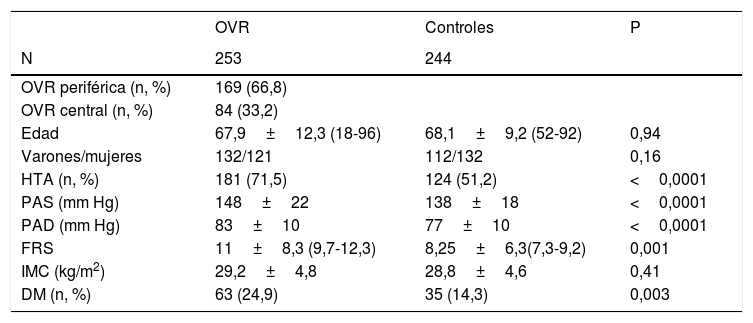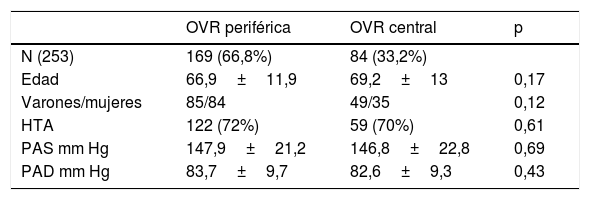Analizar la prevalencia de la hipertensión arterial (HTA), el valor de la presión arterial sistólica (PAS), el de la presión arterial diastólica (PAD) y el score de riesgo vascular de Framingham (FRS) en los sujetos con obstrucción venosa retiniana (OVR) y un grupo control.
Pacientes y métodoEstudio prospectivo de casos y controles (transversal) de todos los pacientes con el diagnóstico de OVR remitidos a la consulta de medicina interna, comparándolos con un grupo control. Se analizaron las variables clínicas y de laboratorio.
ResultadosSe estudiaron 253 pacientes con OVR (132 varones y 121 mujeres) y 244 controles (112 varones y 132 mujeres) de edad similar (67,9±12,3 vs. 68,1±9,2 años). La prevalencia de HTA, el valor de la PAS y el de la PAD en la consulta tras la OVR fueron significativamente mayores en los pacientes con OVR que en los controles (71,5% vs. 51,2%), PAS mmHg (148±22 vs. 138±18mmHg), PAD mmHg (83±10 vs. 77±10mmHg). El diagnóstico de la HTA se realizó de novo a partir de la OVR en el 23,8% de los casos. Se encontraron diferencias significativas en el FRS entre los pacientes con OVR y los controles 11±8,3 vs. 8,25±6,3. No hubo diferencias en ninguno de los parámetros estudiados entre los pacientes con OVR periférica y central.
ConclusionesLa hipertensión es muy prevalente y significativamente más frecuente en los pacientes con OVR que en los controles. El diagnóstico y tratamiento de la misma se establece frecuentemente a partir de la OVR. El FRS es mayor en los pacientes con OVR. No hay diferencias en los parámetros estudiados entre los sujetos con OVR central y periférica. Sugerimos considerar la OVR un evento vascular a la hora de definir los objetivos terapéuticos.
To determine the prevalence of arterial hypertension (AHT), systolic blood pressure (SBP), the diastolic blood pressure (DPB), and the Framingham vascular risk score (FRS), in subjects with retinal vein occlusion (RVO), as well as in a control group.
Patients and methodA prospective, cross-sectional case and control study was conducted on all patients with a diagnosis of RVO referred to the General Medicine Clinic, and comparing them with a control group. An analysis was performed on the clinical and laboratory variables.
ResultsA total of 253 patients with RVO were studied (132 males and 121 females) and 244 controls (112 males and 132 females) of similar age (67.9±12.3 vs. 68.1±9.2 años). The prevalence of AHT, and the SBP and DPB values in the clinic after the RVO were significantly higher in patients with RVO than in the controls (71.5% vs. 51.2%), SBP mmHg (148±22 vs. 138±18mmHg), DBP mmHg (83±10 vs. 77±10mmHg). The de novo diagnosis of AHT was made from the RVO in 23.8% of the cases. Significant differences were found in the FRS between the patients with RVO and the controls (11±8.3 vs. 8.25±6.3. There were no differences in any of the parameters studied between patients with peripheral or central RVO.
ConclusionsHypertension is very prevalent as significantly more common in patients with RVO than in controls. Its diagnosis and treatment is often established from the RVO. The FRS is greater in patients with RVO. There were no differences in any of the parameters studied between patients with peripheral or central RVO. It is suggested that RVO should be considered a vascular event when defining therapeutic objectives.
Artículo
Comprando el artículo el PDF del mismo podrá ser descargado
Precio 19,34 €
Comprar ahora







